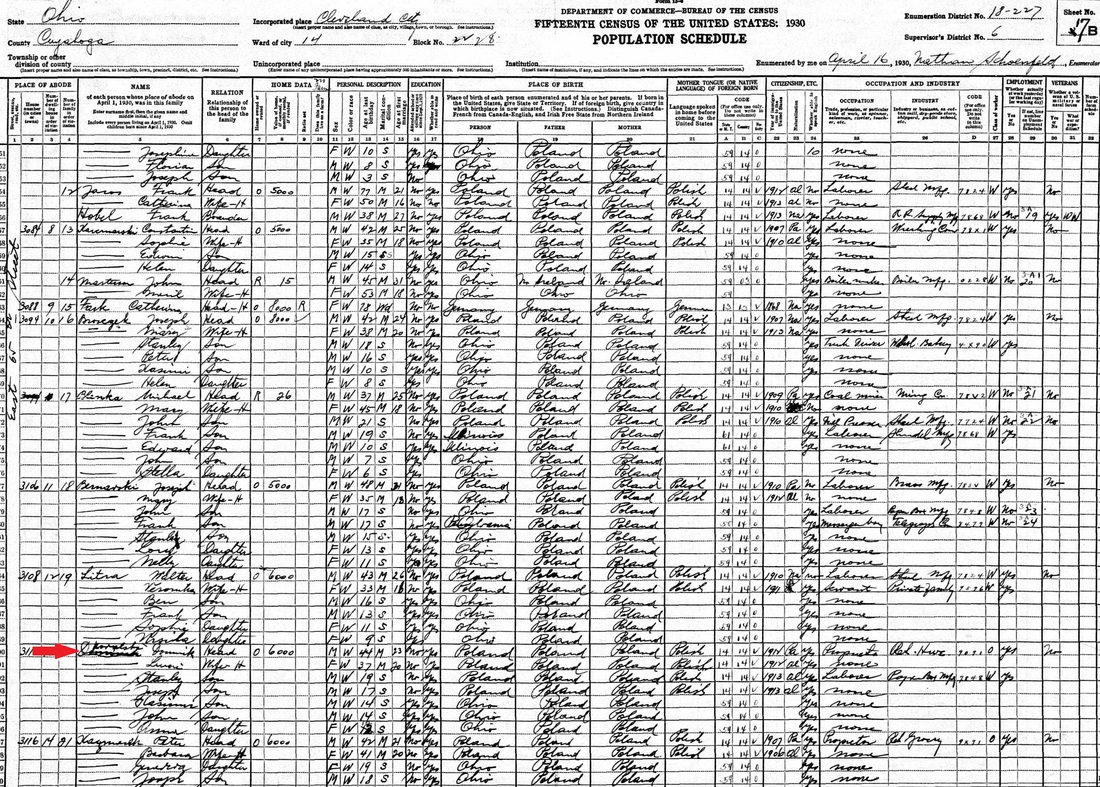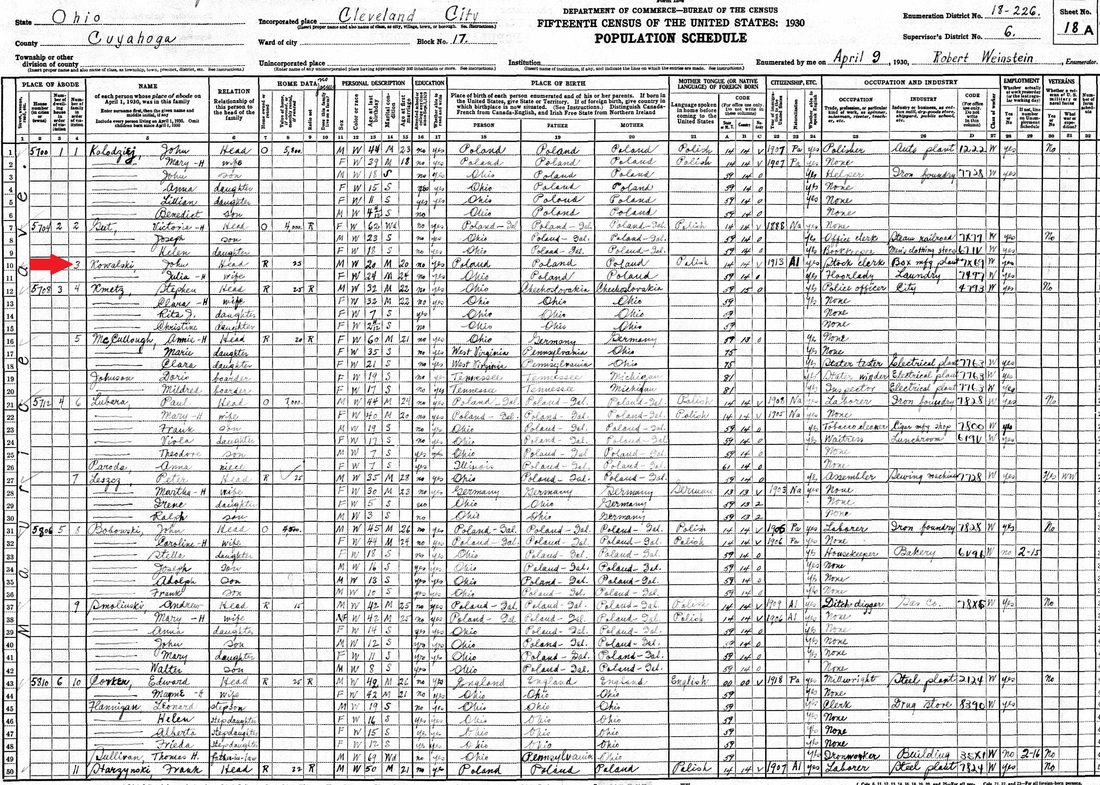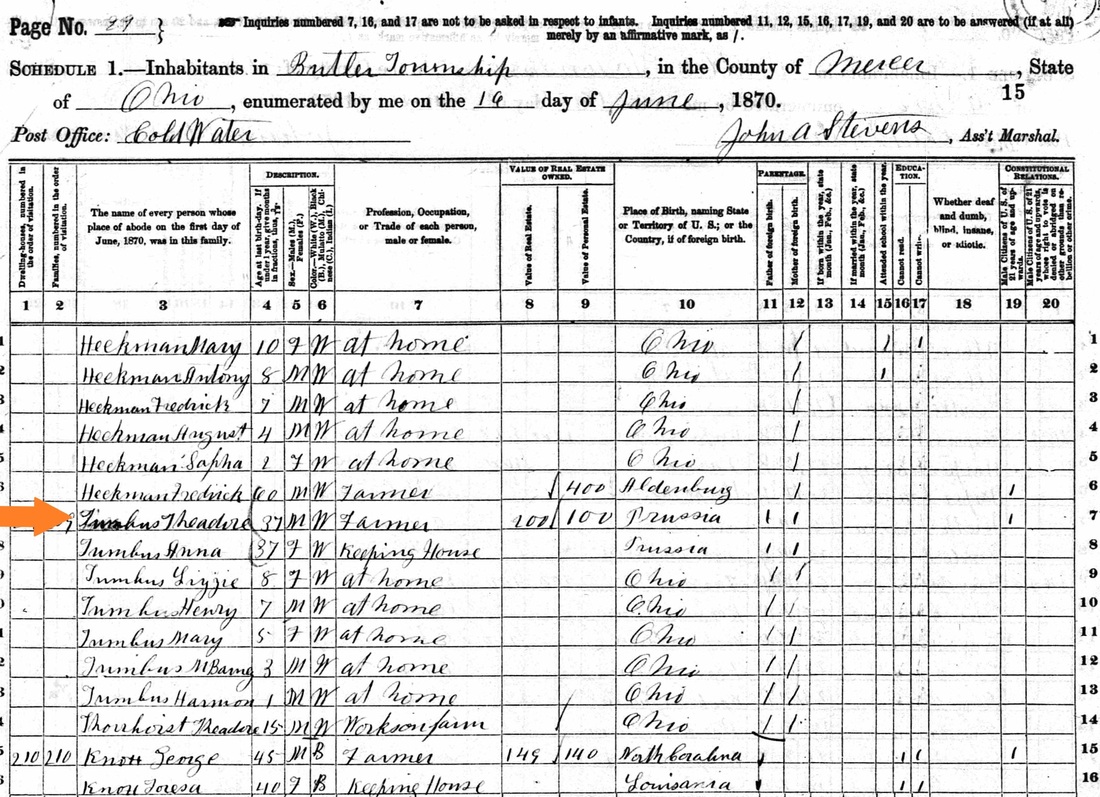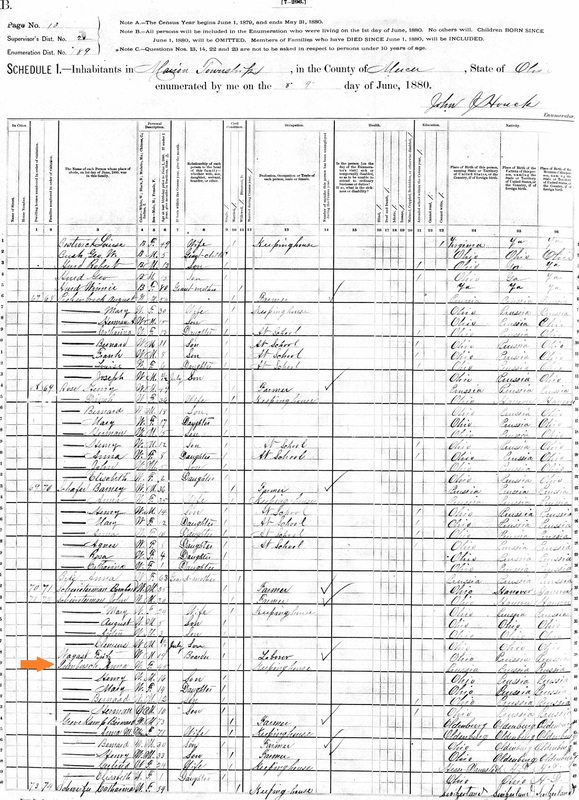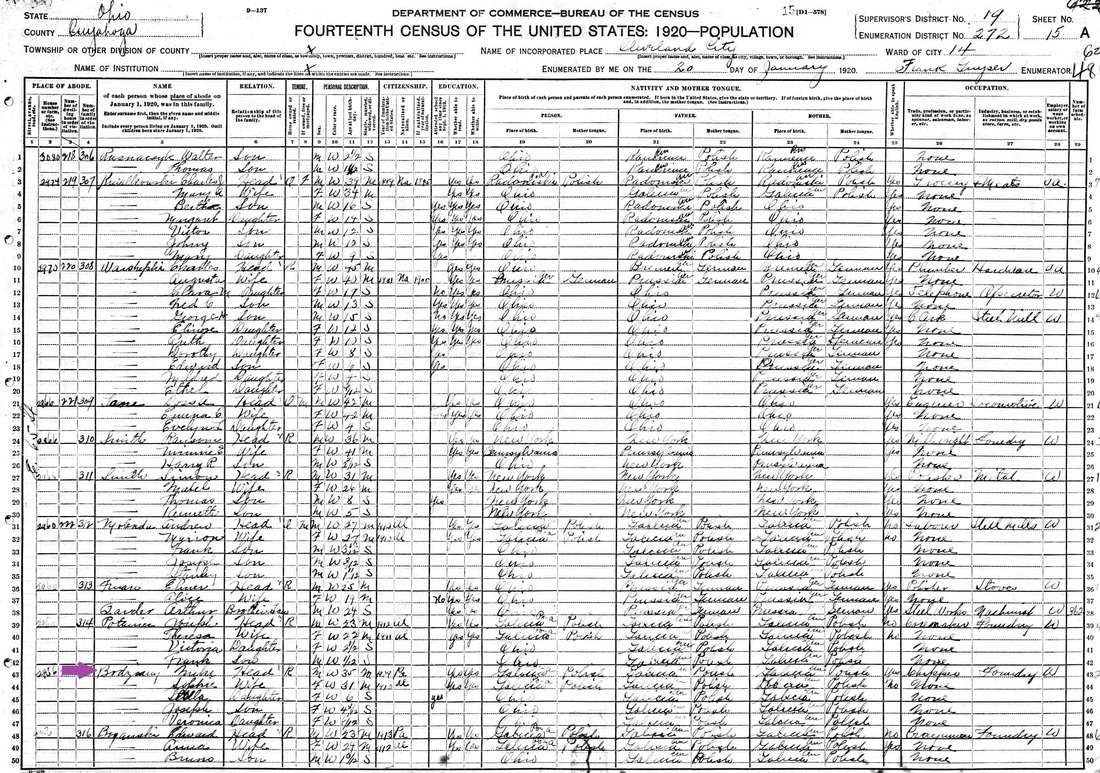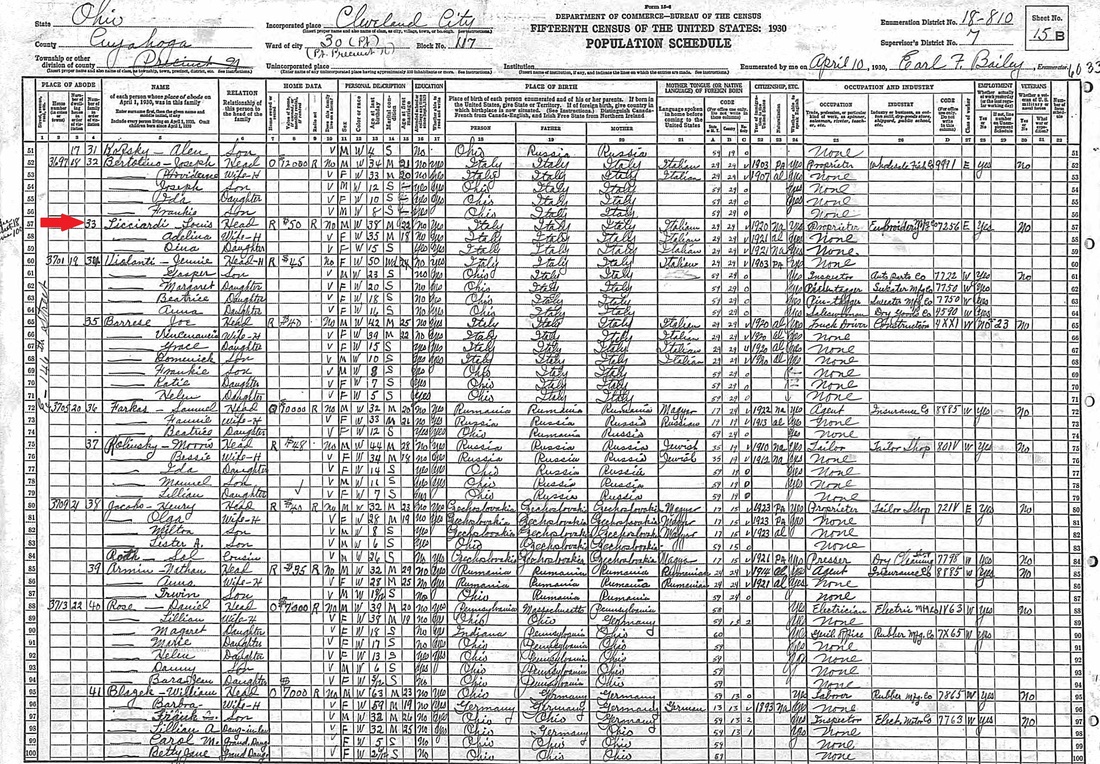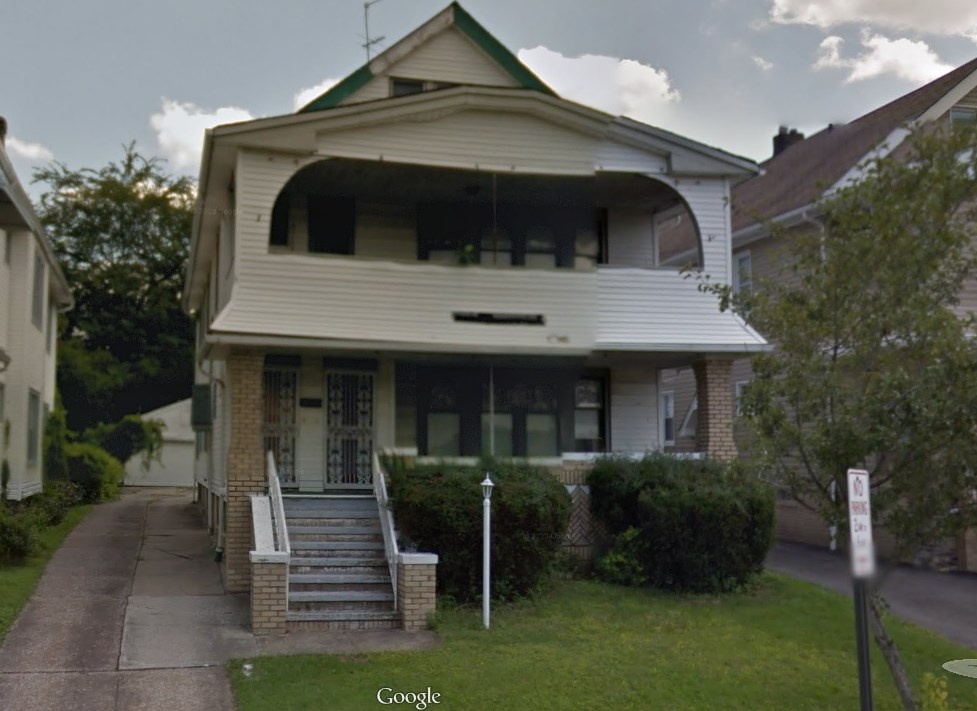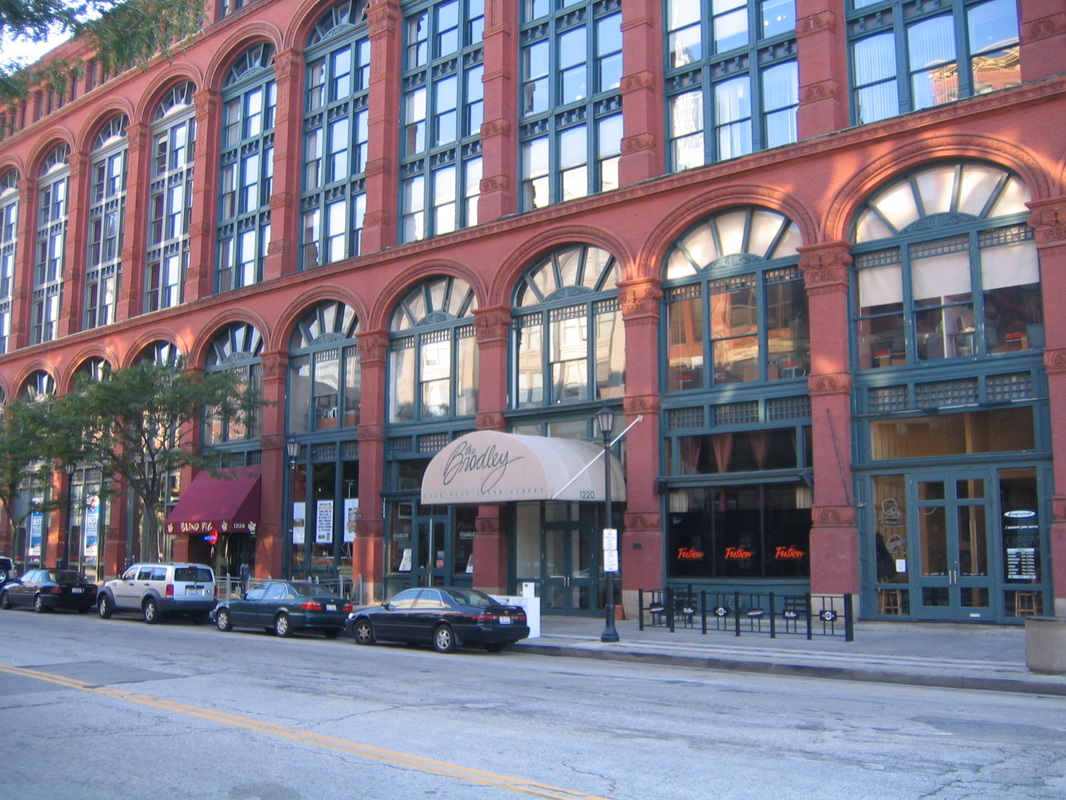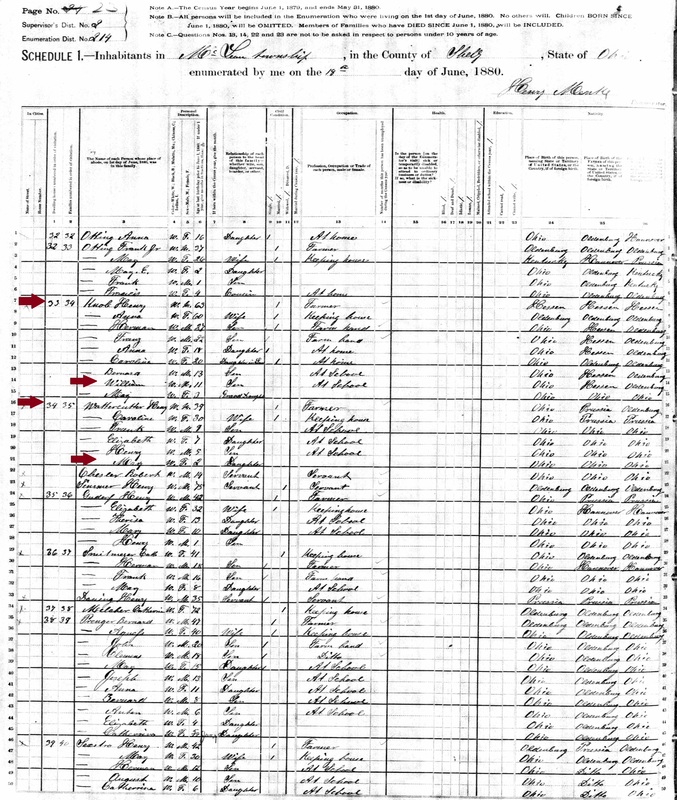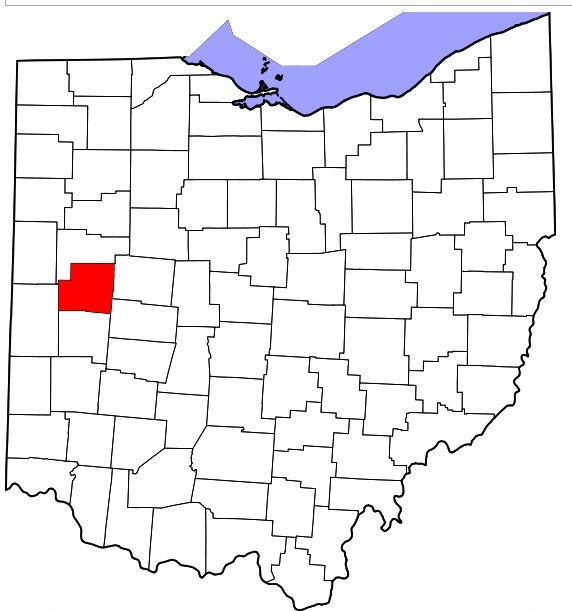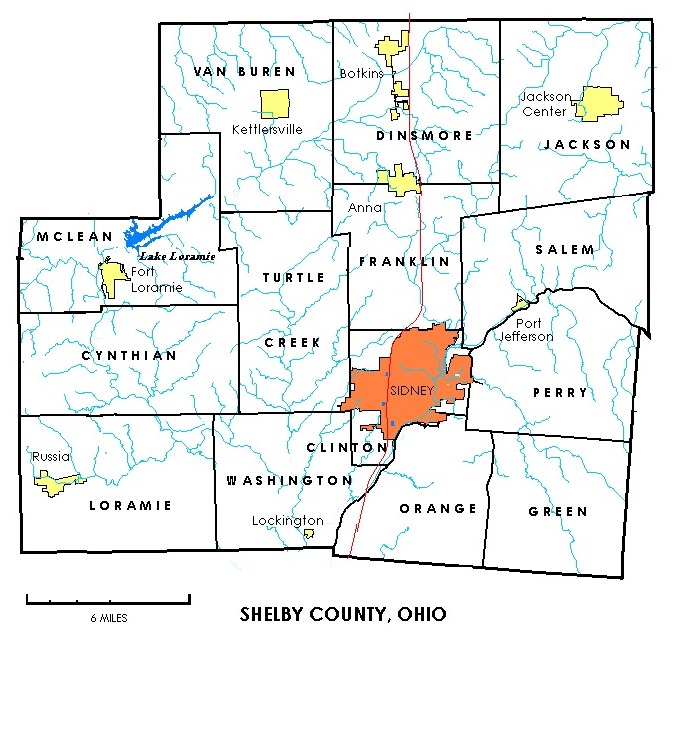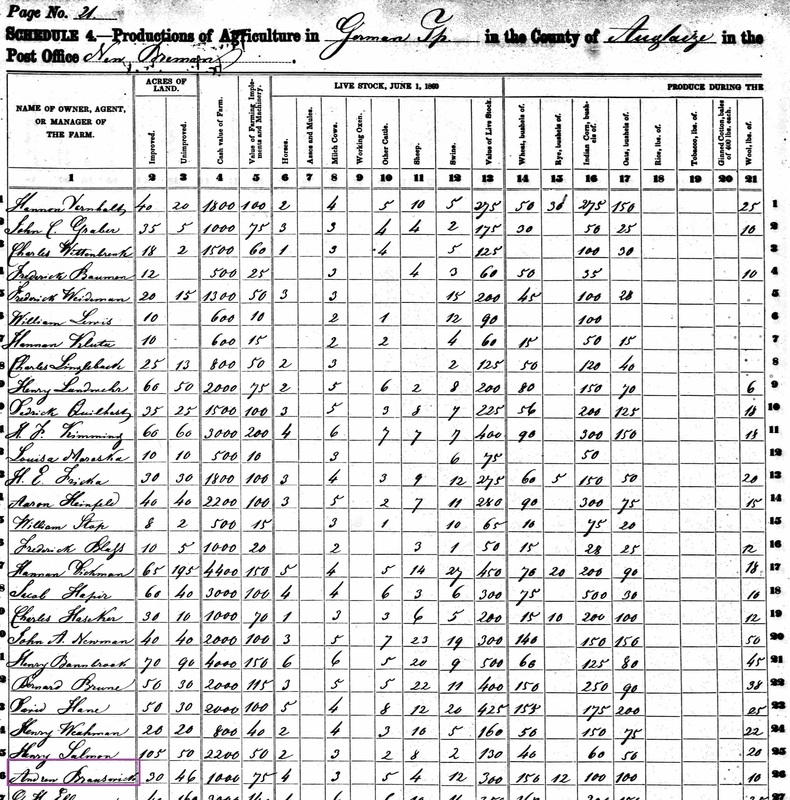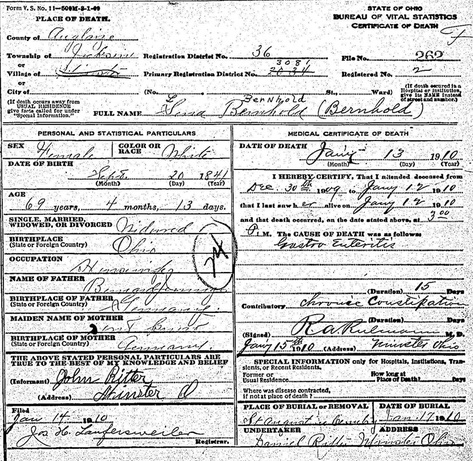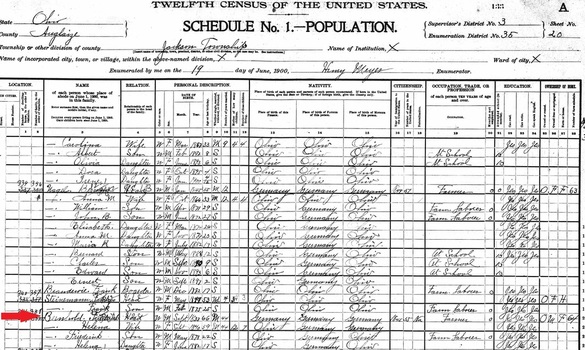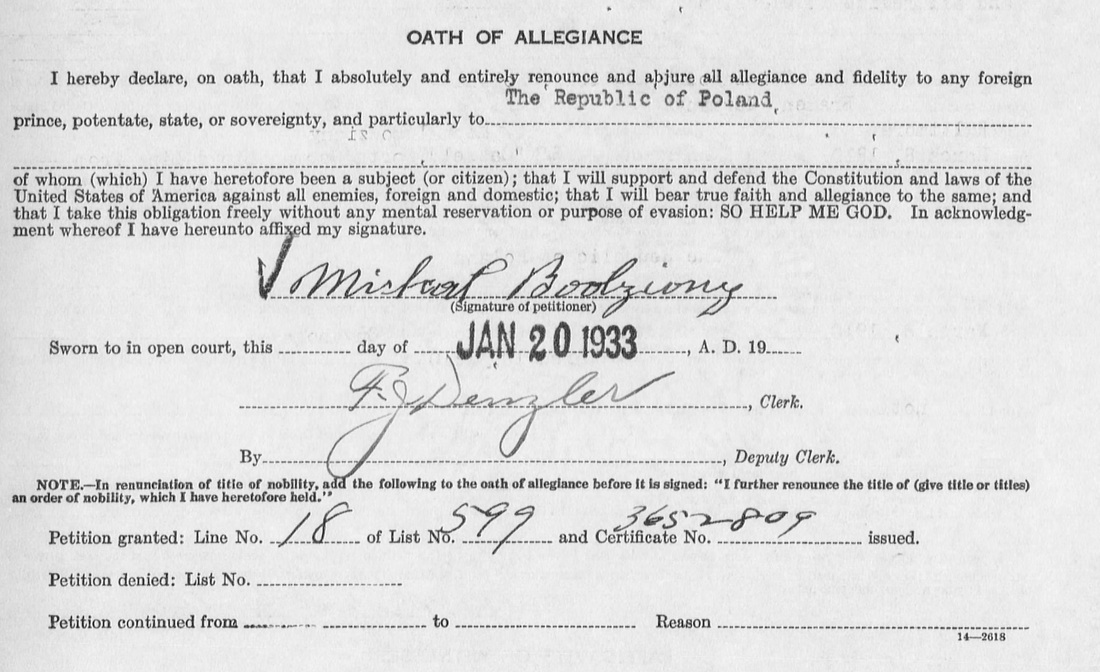|
In 1930, my great-grandfather lived with his family at 3110 E. 65th Street in Cleveland, Ohio where he owned and operated a hardware store. Dominik is living with his second wife, Lucy, who he married in 1921. After Lucy, we see Stanley, Joseph, and Kasimir (Casimer), who are Dominik's sons from his first marriage. The last two people listed are John and Anne, who are Lucy's children from her first marriage. John and Anne should be listed as step-children, and should not be listed under the surname of 'Kowalski.' They should instead have the name of Demitrus, which was their father's name. Mistakes like this are quite common in census forms where blended families are involved. The census enumerator simply assumes that all of the children in the household have the same surname as the head of household, which is, of course, not always the case. (Click on image for larger view.) Dominik's eldest son, John, got married in 1929 and was living with his wife, Julia, just a half a mile away on Maurice Avenue. ©2013, copyright Emily Kowalski Schroeder
0 Comments
This week, my census post is about the family of Theodor Tumbusch, one of my husband's great-great-grandfathers. Theodor arrived in the U.S. in June 1861. He came over on the same ship as Anna Rasing, who he married in Mercer County, Ohio in August 1861. It is most likely that they emigrated from Germany together, with the intention of marrying in the States, but, who knows, maybe it was a 'ship romance,' instead. The first U.S. census in which they appear the 1870 census (click for larger image): By 1870, Theodor and Anna have five children: Elizabeth (Lizzie), Henry, Mary, Bernard (Barney), and Herman. They live in Butler Township in Mercer County. Because Theodor is a farmer, I also tried to find him in the 1870 U.S. Agriculture Census, but, unfortunately, individual farms are not listed for Mercer County - just a summary for each township. So, I don't really have any more information on what was produced on the farm. The 'value of real estate' listed on this form is only $200. Compared with some of the other real estate values for farmers in this township, it appears as if the Tumbusch farm was likely quite small. Unfortunately, Theodor would not live to see 1871. He passed away on December 10, 1870 at the age of 36. I have not been able to find his death record, but I imagine the death was a sudden one. His will is not located in the microfilmed probate records of Mercer County, and, in fact, the index states that no papers have been located for the probate file number. In the end, Anna was left to run the farm alone with five young children to care for. This is one of those times in which I had more information about a person and family. Anna never remarried. How did she run a farm, especially in the years immediately following Theodor's death? I'm sure she had help from her church and community, but there is no doubt that her children must have had to 'grow up' quickly and help with the chores and farming. In the 1880 census, she is listed as head of household living with her four children, Henry, Mary, Bernard, and Herman. (I am unsure as to whether Elizabeth had died or simply got married; she would have been about 18 in 1880, so it's possible.) The family is also no longer living in Butler Township, but have instead relocated to Marion Township. Next to Bernard and Herman's name, who are ages 12 and 10 respectively, there is a check for 'Attended school within the census year.' Being a widow with no other live-in farmhands, Anna could have very easily justified keeping her two youngest sons home from school at this age. But she didn't, and I think it's admirable that she allowed them to get an education, especially when it may have made her life a bit harder. Fortunately, I WAS able to find Anna and her farm in the 1880 U.S. Agriculture Census. As suspected, they have a very small 30-acre farm with only a few cows and a handful of pigs. It was probably very much just a subsistence farm and the family was probably quite poor. ©2013, copyright Emily Kowalski Schroeder
This week's census form is the first U.S. census on which my Polish great-grandparents, Michael and Sophie Bodziony, appear. As the census form states, both Michael and Sophie were ethnic Poles from Galicia, a region in Eastern Europe that was part of Austria-Hungary at the time of their births in the 1880s. (Today, half of this region is located in Poland, and the other half is in the Ukraine.) Although the form states that Michael arrived in 1909 and Sophie in 1910, immigration papers and ship manifests prove that they both arrived in 1910. Michael and Sophie are listed with their three children, Stella, Joseph, and Veronica. Sophie actually gave birth to two other baby boys between 1911 and 1920, one who was stillborn and one who died just hours after birth. The family rented living space in a Cleveland neighborhood that was predominantly Polish; The census form indicates that Michael could speak English, but Sophie still could not. Michael worked as a chipper in a foundry. (I talk more about his job in this post.) ©2013, copyright Emily Kowalski Schroeder
This Sunday, I am looking at the first U.S. Census that my Italian great-grandparents appear in. Louis (Luigi) Licciardi came to America in late 1920 and his wife, Adele, followed with their two young daughters, Dina and Yola, in 1921. In 1930, the family is renting part of a duplex home on Cleveland's east side. Louis owns an embroidery business on West 6th Street in downtown Cleveland's Warehouse District. I'm not quite sure why, but the census enumerator listed my Great Aunt Yola separate from the rest of the family. (And they got her first name a bit wrong, but, hey, that happens all the time.) He did make a note of it though and points the reader in the right direction as to where she IS listed. Here are a couple of Cleveland city directories. The one on the left is from 1928 and gives the address of Louis' embroidery business. The one on the right is from 1930 and shows their home address. (Click on images for larger view.) Here is what the house that they lived in looks like today via Google Street View. Real estate data shows that it was built in 1927, and since the 1928 Cleveland residential directory lists them as living there in 1928, they were very likely the first occupants. Based on the census form, it looks as if my great-grandparents rented from the owner, Joseph Bertolius, who also lived there with his family. And finally, here is the building in which my great-grandfather, Louis, ran his embroidery business in 1930. (He later moved the business to E. 25th St.) It is known as the Bradley Building. It was completely renovated in the late 20th century, and today it is an apartment building with shops and restaurants on the main floor. ©2013, copyright Emily Kowalski Schroeder
I have been doing some additional research on the Knob family this week, so I decided to feature them in this week's Census Sunday. William Knob and Mary Watercutter were two of my husband's great-great grandparents on his dad's side of the family. William was the youngest child of Henry and Anna (Pancier) Knob, both German immigrants, and Mary's grandfather, Ferdinand, was also a German immigrant who came over in 1834. (This area of western Ohio was largely settled by German Catholic farmers in the 19th century.) Here are both families as 'next-door' neighbors in the 1880 census, about 17 years before William and Mary get married. They are living in McLean Township in Shelby County. There are maps below for reference. ©2013, copyright Emily Kowalski Schroeder
Census Sunday is a weekly prompt sponsored by Geneabloggers in which family history bloggers are encouraged to talk about how census records help us learn about our ancestors. Andrew Brunswick was my husband's 3x great-grandfather. He emigrated from Germany to America in 1853 and became a farmer in western Ohio's Auglaize County. Here he is with his family in the 1860 census: He is listed with his wife, Philomena, and young daughters, Catherine and Theresia. (The transcription of first names is slightly incorrect as usual :-) A boy by the name of Clements Holdman is also listed, along with a Theresia Brunswick, who is enumerated as a 'domestic.' I am fairly certain that Theresia Brunswick is Andrew's youngest sister, although I have some more research to do regarding her. For the longest time, I had trouble figuring out who the boy was, especially since this particular census form does not list relations between family members. Although I'm sure he did much work on Andrew's farm, he is a little young to be a hired farmhand and he is not listed as a farmhand in the occupation column. Hmmm... Andrew's wife Philomena had a maiden name of Oldendiek (or Oldendick depending on the source). Earlier this year, I found Andrew and Philomena's wedding record in a book indexing Mercer County marriages. In her marriage record, Philomena's maiden name was listed as 'Holdink,' which is not really that different from Oldendiek phonetically-speaking. I am willing to go out on a limb and say that Clements 'Holdman' is probably Philomena's younger brother. As to why he may be living with his older sister, I don't know. In fact, there is much I do not yet know about this Oldendiek/Oldendick family that I still need to try to research. Andrew Brunswick is also listed in 1860's agricultural census. I love these 19th century ag census schedules because they give us a sense of what our ancestor really DID on their farms. Here is Andrew listed at the bottom of the images below (click for larger image). Andrew had a total of 76 acres of land valued at $1000. The family had five horses, three milking cows, five general cattle, four sheep, and twelve pigs as livestock, which had a value of $300. Over the past year, his farm had produced 150 bushels of wheat, twelve bushels of rye, a hundred bushels each of Indian corn and oats, and forty bushels of barley. Their sheep had yielded ten pounds of wool, and the milk cows helped them produce 150 pounds of butter. The farm also produced 14 tons of hay.
©2013, copyright Emily Kowalski Schroeder (Matrilineal Monday is a weekly prompt from Geneabloggers that encourages bloggers to write about an individual female ancestor or a female ancestor's lineage.) So far in my blog, I've talked mostly about ancestors about whom I have a decent amount of information. Today, however, I'm writing about a woman and her family about whom I have little information. Helena Janning Bernhold is one of my husband's paternal ggg-grandmothers. According to her birth certificate (see below), she was born September 8, 1841 in Ohio and she passed away January 13, 1910 in or near Minster, Ohio (Jackson Twp, Auglaize County). According to the 1900 U.S. Census, she married Frederich ('Fred' or 'Fritz') Bernhold in 1855 or 1856. (I have not yet been able to find a marriage record.) They had 12 children, only 7 of whom were still living at the turn of the century. Her death certificate and the 1900 census form say that she was born in Ohio, yet in the 1860 and 1880 census schedules she is listed as being born in Germany. Grrrr.... Her death certificate also mentions that her father's name was Bernard. There is a record of a 'Bernard Johning," age 53, in Auglaize County in the 1850 U.S. Census. He is listed with his wife Catherine and one daughter named 'Lena,' who is listed as being ten years old. It says he and his wife were born in Germany, but that their daughter was born in Ohio. I am pretty confident that this IS the Janning family I am interested in. I have also found an index of people buried in the "Old Section" of St. Augustine's Cemetery in Minster, Ohio. In this index, there is a record of a Bernard Janning who was born in 1796 and who died January 5, 1851. This date of death would explain why I am unable to find him in any future census schedules, although I have not located an actual record of his death (yet). This 1860 census schedule lists a 60-year old "Catherine Bernholt" living with Frederich and Lena and their young daughters, Catherine and Mary. Even though the surname is incorrect, I'm pretty sure this is the widowed Mrs. Janning: the age matches, Frederich's mom was not named Catherine (and I found her elsewhere in this census, anyway), and older widows usually went to live with family members in this period.
Needless to say, I still have many questions about this particular branch of my husband's tree. When did Bernard and Catherine immigrate to America? Where in Germany were they from? Were they married in Germany or Ohio? What was Catherine's maiden name? Did they have any other children besides Helena - if those children were grown, did they immigrate to America as well or did they stay in Germany? When did Catherine die and where is she buried? The best chance I have of answering (some of) these questions definitely requires a trip to Minster, Ohio to look through St. Augustine Church's records. Then, I could really find whether Helena was born in Ohio or Germany and I could look for a marriage record for Catherine and Bernard. It's not a short drive from where I live in Indiana, and it would take some planning, but maybe someday. (How do the Bernholds and Jannings fit into hubby's family tree? Frederich and Helena (Janning) Bernhold are the parents of Anna Bernhold, who married Joseph Schroeder in 1887.) Yesterday evening after the kids went to sleep, I was casually fooling around on FamilySearch.org, trying to find any records from Poland regarding my great-grandparents. I didn't intend to spend much time on it; I was just killing some time before my own bedtime. I didn't find any Polish records, but I did FINALLY find my great-grandfather and his family in the 1930 U.S. Census. I had made several earnest attempts over the past year and a half to find it, with no success. Their last name of 'Kowalski' was transcribed as 'Koralski,' and Ancestry.com had listed 'Korchske' as an alternate possibility, which, of course, was WAY off. I suppose this may have been the first time I used the FamilySearch search engine on this name, and it obviously did a better job of pulling up close matches than the Ancestry search engine did so many times before. It was nice to be able to add a 'missing piece' to one of my family binders before going to sleep. If you use both FamilySearch and Ancestry regularly, do you find that one search engine performs better than the other for particular situations/topics? I am curious of other peoples' opinions. :-)  Source Citation: Year: 1930; Census Place: Cleveland, Cuyahoga, Ohio; Roll: 1770; Page: 17B; Enumeration District: 227; Image: 285.0; FHL microfilm: 2341504. Source Information: Ancestry.com. 1930 United States Federal Census [database on-line]. Provo, UT, USA: Ancestry.com Operations Inc, 2002. Original data: United States of America, Bureau of the Census. Fifteenth Census of the United States, 1930. Washington, D.C.: National Archives and Records Administration, 1930. T626, 2,667 rolls. If you use both FamilySearch and Ancestry regularly, do you find that one search engine performs better than the other for particular situations/topics? I am curious of other peoples' opinions. :-)
©2012, copyright Emily Kowalski Schroeder When you are studying your family's history, some of the most exciting documents you can come across in your research are immigration-related papers: Ship manifests and applications for citizenship. Not only do they tell you exactly where and when your ancestors entered the country, but they also contain important information about where your ancestor was from, which is absolutely vital if you want to start researching family lines in other countries. I was excited when I found these sorts of documents belonging to my great-grandfather, Michael Bodziony. I had already known that he was ethnically Polish, obviously spoke Polish and settled in a very Polish community in Cleveland. However, nobody in the family knew where exactly he was from. I found his name on a 1910 ship manifest and looked across the sheet from his name to the three columns that read, "Nationality (country of which citizen or subject), Race of People, Country (of last residence.)" And in these columns is listed, "Austria, Polish, Austria." Ok, now I'm not an expert in 19th central European history, but I vaguely remember learning in history class about the extent and longevity of the Austrian Empire, so I am not surprised. I then was able to find Michael's citizenship papers. Here is his 1929 Declaration of Intention: I also found a reference to Galicia as Michael and Sophie Bodziony's place of birth in the 1920 U.S. Census:  Source Citation: Year: 1920; Census Place: Cleveland Ward 14, Cuyahoga, Ohio; Roll: T625_1366; Page: 15A; Enumeration District: 272; Image: 37. Source Information: Ancestry.com. 1920 United States Federal Census [database on-line]. Provo, UT, USA: Ancestry.com Operations Inc, 2010. Images reproduced by FamilySearch. I do NOT remember learning anything about Galicia at any point in my schooling, so I was curious. Wikipedia to the rescue! The Kingdom of Galicia and Lodomeria was part of Austria-Hungary from 1772-1918, so my great-grandfather WAS technically born in Galicia, Austria and it WAS still part of Austria when he immigrated to America in 1910. (By the way, the name of his birthplace was spelled incorrectly - it should have read, 'Swiniarsko.') Here are Galicia's borders overlayed on a modern map of the region, and that red dot is the location of Michael's hometown. (Map from http://www.germangenealogist.com/2011/06/03/3331/) Now, by the time Michael took his Oath of Allegiance to the U.S. in 1933, the area in which his birthplace was located had become part of the sovereign nation known as 'The Republic of Poland', which you can see on this form: I enjoyed solving this little mystery for myself, probably because it involved looking at maps, which I love to do. Trying to understand the history behind all these name and border changes was a little more difficult, but I would like to someday read a (good) history of Poland. And I intend to write more blog posts in the future about how historical events in Europe may have influenced my and my husband's ancestors to make the decision to immigrate to America.
©2012, copyright Emily Kowalski Schroeder |
Emily Kowalski SchroederArchives
April 2017
Categories
All
|
| The Spiraling Chains: Kowalski - Bellan Family Trees |
|
